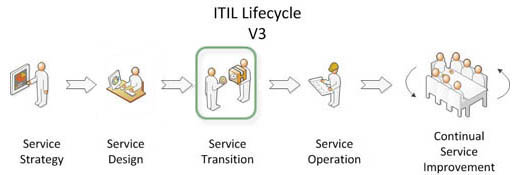We use Service Transition to package, build, test and deploy services which were previously specified by our customer's requirements. We manage all of these processes whilst carefully considering and evaluating our capacity and resource usage. Whilst transitioning a service into production we endeavour to keep within the cost, quality and time estimates. We use lifecycle processes such as Change Management, Configuration Management and Knowledge Management but other processes such as Transition Planning and Support are at the heart of Transition.

Service Design is the primary source of input to the Transition stage, this includes things such as the Service and Customer Portfolios. These come wrapped up in the Service Design package which describes in detail the elements of the service to be transitioned.
Before we release a new service or deploy a changed service, we evaluate and weigh up the risk and capabilities. Service assets are identified throughout the Transition stage and we provide knowledge to Release and Deployment Management to support prompt and effective release cycles.
Given that the service has been fully identified (as part of the Service Design), the Transition stage develops build or installation methods which are used (and reused) to push the service through test and into production environments (and even to restore the service in case of disaster recovery or failure). We're looking for a smooth operation which is slick and effective.
It's a kind of 'factory' mentality; we want to ensure that services can be churned out at a high rate whilst ensuring quality and low costs. We need to be able to handle high volumes of change and release, with a high success rate.
GoalThe ultimate goal of Service Transition is to help customers cope with and understand the services. We actively discuss the new service and help to integrate it into their day to day processes whilst minimizing risk and performance issues.
Lifecycle processes used during Service Transition include- Change Management
- Service Asset and Configuration Management
- Knowledge Management
Core processes during Service Transition include- Planning and Support for Transition
- Change Management
- Configuration Management
- Release and Deployment Management
- Testing and Validation
- Evaluation
- Knowledge Management
Some of the inputs required include- Service Portfolio
- Customer Portfolio
- Contract Portfolio
- Policies
These all come from the previous lifecycle stage - Service Design.
Outputs from the Service Transition stage include- Service Release Package (approved)
- Updated Service Package
- Updated Service
- Updated Contract Portfolio
See also- BIA - Business Impact Analysis
- CFIA - Component Failure Impact Analysis
- CMM - Capability Maturity Model
- CSP - Core Service Package
- ITSM - IT Service Management
- itSMF - IT Service Management Forum
- MTBSI - Mean Time Between Service Incidents